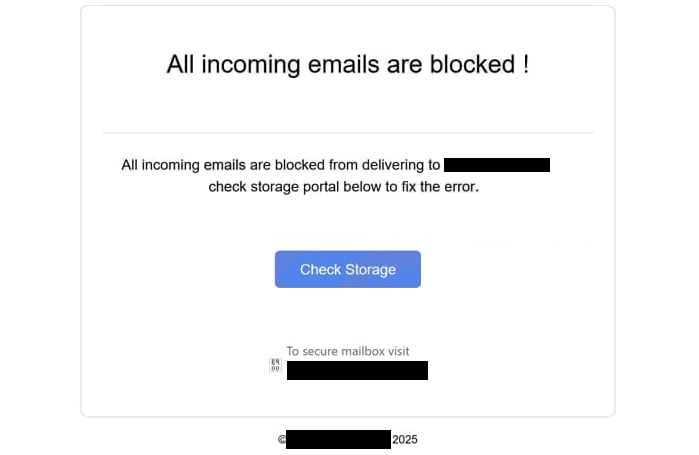Remove “All Incoming Emails Are Blocked” email
The “All Incoming Emails Are Blocked” email is part of a phishing campaign that intends to steal users’ email login credentials. The email is disguised as a notification from the email service provider, supposedly informing recipients that all incoming emails have been blocked because of a storage error. The email asks that recipients click on the provided button to fix the error. However, if users click on the button, they will be taken to a phishing site that asks them to log in to their email accounts by typing their passwords. If users do that, the credentials will be sent to the malicious actors operating this phishing campaign. This could potentially allow malicious actors to access those email accounts.
The “All Incoming Emails Are Blocked” email warns users that all incoming emails are blocked from being delivered because of supposed storage errors. The email urges users to fix the errors by clicking the provided “Check Storage” button. However, if users click on the button, they will be led to a phishing site mimicking the email provider’s login page. If users enter their credentials, they unknowingly hand over their information to cybercriminals behind the scam.
Hackers try to steal email login details because email accounts often contain sensitive personal data and are connected to other accounts. Gaining access to an email account allows malicious actors to exploit information for blackmail or gain entry to connected accounts. Since email credentials are highly sought after, users need to exercise extreme caution.
The full “All Incoming Emails Are Blocked” phishing email is below:
Subject: [-]:Mail Delivery Fail!
All incoming emails are blocked !
–
All incoming emails are blocked from delivering to – check storage portal below to fix the error.
Check StorageTo secure mailbox visit
–
© – 2025
Signs of a phishing email
Phishing campaigns can vary in sophistication. Less sophisticated ones are often generic, targeting many users with identical emails that are not tailored in any way. On the other hand, more sophisticated phishing attempts target specific high-profile individuals or organizations, using a level of personalization that can make them convincing enough to deceive even the most cautious users. However, most regular users are unlikely to be the main targets of such tailored attacks. By being able to recognize common signs, users can effectively spot phishing emails with no difficulty.
When you receive an unsolicited email, always check the sender’s address first, especially if the email asks you to click a link, press a button, or open an attachment. Generic phishing emails often come from obviously fake accounts, so a quick glance can usually reveal them as malicious. Searching the email address online can also help verify if it belongs to the person/company the sender claims to be from. Still, some cybercriminals use subtle tricks, like replacing letters (e.g., “rn” instead of “m”) or adding extra characters to make the address appear legitimate. This has proven to be an effective tactic as users don’t always pay close enough attention, so it’s important that users are always careful with emails.
Another clue is poor grammar and spelling in emails claiming to come from reputable sources, like email providers. Many phishing emails are riddled with mistakes and awkward phrases that would be unusual coming from legitimate senders. For example, this “All Incoming Emails Are Blocked” email has several glaring mistakes, making it clear that it’s a phishing attempt.
To protect yourself from phishing attempts, take your time when dealing with unsolicited emails. Avoid clicking links or opening attachments impulsively. Carefully inspect all unsolicited emails and scan attachments using anti-malware tools or services like VirusTotal. Always ask yourself whether the email seems suspicious or aligns with the sender’s usual communication style.
“All Incoming Emails Are Blocked” phishing email removal
If you get this “All Incoming Emails Are Blocked” email, ignore it completely and do not interact with it. If you’ve already engaged with it and typed in your password, change it immediately, provided you still have access to your account. Check for any unusual activity in your account as well. If you’re locked out, try all available recovery options. If recovery doesn’t work, disconnect the email address from any linked accounts to prevent those accounts from being accessed by malicious actors as well.
Site Disclaimer
WiperSoft.com is not sponsored, affiliated, linked to or owned by malware developers or distributors that are referred to in this article. The article does NOT endorse or promote malicious programs. The intention behind it is to present useful information that will help users to detect and eliminate malware from their computer by using WiperSoft and/or the manual removal guide.
The article should only be used for educational purposes. If you follow the instructions provided in the article, you agree to be bound by this disclaimer. We do not guarantee that the article will aid you in completely removing the malware from your PC. Malicious programs are constantly developing, which is why it is not always easy or possible to clean the computer by using only the manual removal guide.

